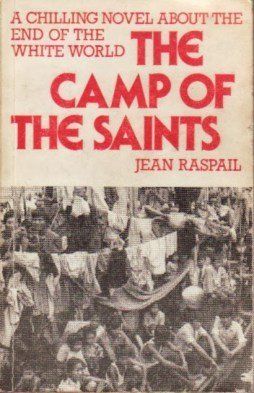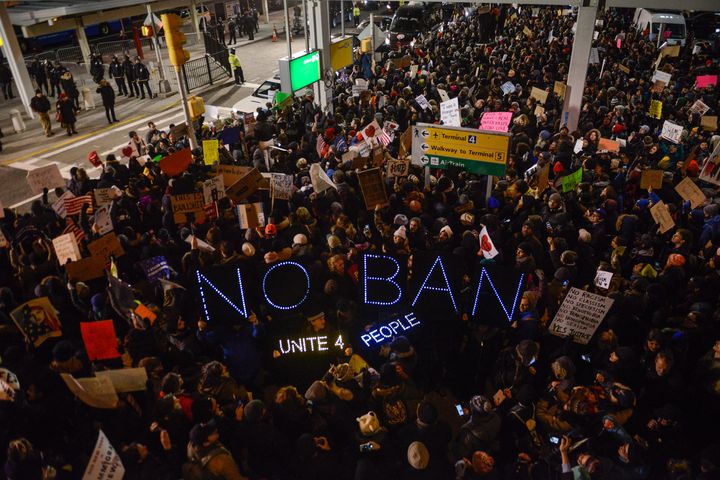PBS: Escaping Eritrea … [Read More...] about ካብ ውሽጢ ቤት ማእሰርታት ኤርትራ
This Stunningly Racist French Novel Is How Steve Bannon Explains The World
“The Camp of the Saints” tells a grotesque tale about a migrant invasion to destroy Western civilization.
Stephen Bannon, President Donald Trump’s chief strategist and the driving force behind the administration’s controversial ban on travelers from seven Muslim-majority countries, has a favorite metaphor he uses to describe the largest refugee crisis in human history.
“It’s been almost a Camp of the Saints-type invasion into Central and then Western and Northern Europe,” he said in October 2015.
“The whole thing in Europe is all about immigration,” he said in January 2016. “It’s a global issue today — this kind of global Camp of the Saints.”
“It’s not a migration,” he said later that January. “It’s really an invasion. I call it the Camp of the Saints.”
“When we first started talking about this a year ago,” he said in April 2016, “we called it the Camp of the Saints. … I mean, this is Camp of the Saints, isn’t it?”
Bannon has agitated for a host of anti-immigrant measures. In his previous role as executive chairman of the right-wing news site Breitbart — which he called a “platform for the alt-right,” the online movement of white nationalists — he made anti-immigrant and anti-Muslim news a focus.
But the top Trump aide’s repeated references to The Camp of the Saints, an obscure 1973 novel by French author Jean Raspail, reveal even more about how he understands the world. The book is a cult favorite on the far right, yet it’s never found a wider audience. There’s a good reason for that: It’s breathtakingly racist.
“[This book is] racist in the literal sense of the term. It uses race as the main characterization of characters,” said Cécile Alduy, professor of French at Stanford University and an expert on the contemporary French far right. “It describes the takeover of Europe by waves of immigrants that wash ashore like the plague.”
The book, she said, “reframes everything as the fight to death between races.”
Upon the novel’s release in the United States in 1975, the influential book review magazine Kirkus Reviews pulled no punches: “The publishers are presenting The Camp of the Saints as a major event, and it probably is, in much the same sense that Mein Kampf was a major event.”
Linda Chavez, a Republican commentator who has worked for GOP presidents from Ronald Reagan to George W. Bush but opposed Trump’s election, also reviewed the book back then. Forty years later, she hasn’t forgotten it.
“It is really shockingly racist,” Chavez told The Huffington Post, “and to have the counselor to the president see this as one of his touchstones, I think, says volumes about his attitude.”

The plot of The Camp of the Saints follows a poor Indian demagogue, named “the turd-eater” because he literally eats shit, and the deformed, apparently psychic child who sits on his shoulders. Together, they lead an “armada” of 800,000 impoverished Indians sailing to France. Dithering European politicians, bureaucrats and religious leaders, including a liberal pope from Latin America, debate whether to let the ships land and accept the Indians or to do the right thing — in the book’s vision — by recognizing the threat the migrants pose and killing them all.
The non-white people of Earth, meanwhile, wait silently for the Indians to reach shore. The landing will be the signal for them to rise up everywhere and overthrow white Western society.
The French government eventually gives the order to repel the armada by force, but by then the military has lost the will to fight. Troops battle among themselves as the Indians stream on shore, trampling to death the left-wing radicals who came to welcome them. Poor black and brown people literally overrun Western civilization. Chinese people pour into Russia; the queen of England is forced to marry her son to a Pakistani woman; the mayor of New York must house an African-American family at Gracie Mansion. Raspail’s rogue heroes, the defenders of white Christian supremacy, attempt to defend their civilization with guns blazing but are killed in the process.
Calgues, the obvious Raspail stand-in, is one of those taking up arms against the migrants and their culturally “cuckolded” white supporters. Just before killing a radical hippie, Calgues compares his own actions to past heroic, sometimes mythical defenses of European Christendom. He harkens back to famous battles that fit the clash-of-civilizations narrative — the defense of Rhodes against the Ottoman Empire, the fall of Constantinople to the same — and glorifies colonial wars of conquest and the formation of the Ku Klux Klan.
Only white Europeans like Calgues are portrayed as truly human in The Camp of the Saints. The Indian armada brings “thousands of wretched creatures” whose very bodies arouse disgust: “Scraggy branches, brown and black … All bare, those fleshless Gandhi-arms.” Poor brown children are spoiled fruit “starting to rot, all wormy inside, or turned so you can’t see the mold.”
The ship’s inhabitants are also sexual deviants who turn the voyage into a grotesque orgy. “Everywhere, rivers of sperm,” Raspail writes. “Streaming over bodies, oozing between breasts, and buttocks, and thighs, and lips, and fingers.”
The white Christian world is on the brink of destruction, the novel suggests, because these black and brown people are more fertile and more numerous, while the West has lost that necessary belief in its own cultural and racial superiority. As he talks to the hippie he will soon kill, Calgues explains how the youth went so wrong: “That scorn of a people for other races, the knowledge that one’s own is best, the triumphant joy at feeling oneself to be part of humanity’s finest — none of that had ever filled these youngsters’ addled brains.”
The Camp of the Saints — which draws its title from Revelation 20:9 — is nothing less than a call to arms for the white Christian West, to revive the spirit of the Crusades and steel itself for bloody conflict against the poor black and brown world without and the traitors within. The novel’s last line links past humiliations tightly to its own grim parable about modern migration. “The Fall of Constantinople,” Raspail’s unnamed narrator says, “is a personal misfortune that happened to all of us only last week.”

Raspail wrote The Camp of the Saints in 1972 and 1973, after a stay at his aunt’s house near Cannes on the southern coast of France. Looking out across the Mediterranean, he had an epiphany: “And what if they came?” he thought to himself. “This ‘they’ was not clearly defined at first,” he told the conservative publication Le Point in 2015. “Then I imagined that the Third World would rush into this blessed country that is France.”
Raspail’s novel has been published in the U.S. several times, each time with the backing of the anti-immigration movement.
The U.S. publishing house Scribner was the first to translate the book into English in 1975, but it failed to reach a wide audience amid withering reviews by critics. A rare favorable take appeared in National Review. “Raspail brings his reader to the surprising conclusion that killing a million or so starving refugees from India would be a supreme act of individual sanity and cultural health,” then-Dartmouth professor Jeffrey Hart wrote in 1975. “Raspail is to genocide what [D.H. Lawrence] was to sex.” Hart added that “a great fuss” was being made over “Raspail’s supposed racism,” but that the “liberal rote anathema on ‘racism’ is in effect a poisonous assault upon Western self-preference.”
The book received a second life in 1983 when Cordelia Scaife May, heiress to the Mellon fortune and sister to right-wing benefactor Richard Mellon Scaife, funded its republication and distribution. This time it gained a cult following among immigration opponents.
May’s money has also been instrumental in funding the efforts of John Tanton, the godfather of the anti-immigration movement in the U.S. Tanton, who began as an environmentalist and population control proponent, founded a host of groups focused on restricting immigration, including the Federation of American Immigration Reform, the Center for Immigration Studies, NumbersUSA and U.S. English. May’s fortune has fueled these groups with tens of millions of dollars in contributions over the years.
Linda Chavez was recruited in 1987 to head U.S. English, which advocates for English to be designated the country’s official language. But then a series of disturbing stories painted Tanton’s motives in a racial light. Among other issues, Chavez said she learned that his funding came from the pro-eugenics Pioneer Fund and from May, who Chavez knew had helped publish The Camp of the Saints. Chavez recalled seeing Tanton’s staffers carrying the book around their offices. She quit the group.
Tanton, who insists his opposition to immigration is not connected to race at all, told The Washington Post in 2006 that his mind “became focused” on the issue after reading The Camp of the Saints. In 1995, his small publishing house, Social Contract Press, brought the book back into print for a third time in the U.S., again with funding from May. Historians Paul Kennedy and Matt Connelly tied the book to then-current concerns about global demographic trends in a cover story for The Atlantic.
“Over the years the American public has absorbed a great number of books, articles, poems and films which exalt the immigrant experience,” Tanton wrote in 1994. “It is easy for the feelings evoked by Ellis Island and the Statue of Liberty to obscure the fact that we are currently receiving too many immigrants (and receiving them too fast) for the health of our environment and of our common culture. Raspail evokes different feelings and that may help to pave the way for policy changes.”
In 2001, the book was republished one more time, again by Tanton, and again gained a cult following among opponents of immigration like the border-patrolling Minutemen and eventually the online “alt-right.”

Bannon’s alt-right-loving Breitbart has run multiple articles over the past three years referencing the novel. When Pope Francis told a joint session of Congress that the U.S. should open its arms to refugees in September 2015, Breitbart’s Julia Hahn, now an aide to Bannon in the White House, compared his admonition to Raspail’s liberal Latin American pontiff. And the novel’s thesis that migration is invasion in disguise is often reflected in Bannon’s public comments.
The refugee crisis “didn’t just happen by happenstance,” Bannon said in an April 2016 radio interview with Sebastian Gorka, who now works for the National Security Council. “These are not war refugees. It’s something much more insidious going on.”
Bannon has also echoed the novel’s theory that secular liberals who favor immigration and diversity weaken the West.
“Do you believe the elites in this country have the backbone, have the belief in the underlying principles of the Judeo-Christian West to actually win this war?” he asked Sen. Jeff Sessions (R-Ala.), now the attorney general, in June 2016.
“I’m worried about that. … They’re eroding, regularly it seems to me, classical American values that are so critical to our success,” Sessions replied.
Like Raspail, Bannon has reveled in the past victories of Christendom over Islamic forces.
“If you look back at the long history of the Judeo-Christian West struggle against Islam, I believe that our forefathers kept their stance, and I think they did the right thing,” he said in a 2014 speech broadcast to a conference at the Vatican. “I think they kept it out of the world, whether it was at Vienna [the Battle of Vienna in 1683], or Tours [the Battle of Tours in 732], or other places. … They were able to stave this off, and they were able to defeat it, and they were able to bequeath to us a church and a civilization that really is the flower of mankind.”
Now Bannon sits at the right hand of the U.S. president, working to beat back what Bannon calls “this Muslim invasion.” And Trump is all in on the project. During the campaign, he called for a ban on all Muslims entering the country. His Jan. 28 executive order, since blocked in the courts, turned this campaign idea into executive policy.
Trump has continued to defend the executive order as a life-or-death national security issue. “We cannot allow a beachhead of terrorism to form inside America,” he said in his first speech to a joint session of Congress on Tuesday.
Five days earlier, Trump had called his immigration enforcement efforts a “military operation.”
Although Department of Homeland Security officials walked back that statement, the president’s conflation of immigration with warfare did not go unnoticed.
“They see this as a war,” Chavez said.
Chavez, who supports some of Trump’s economic policy proposals, called the direction the White House is taking on immigration and race “extremely dangerous.” She said Trump’s immigration moves are “a kind of purging of America of anything but our Northern European roots.” Bannon, she added, “wants to make America white again.”
